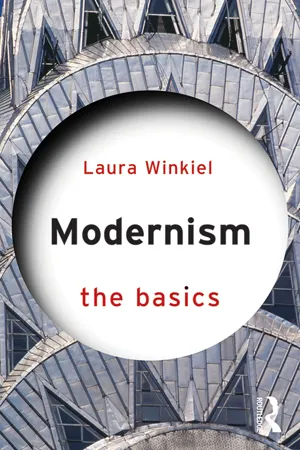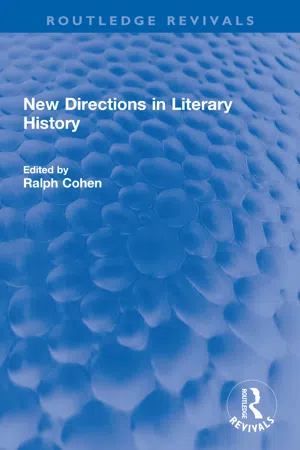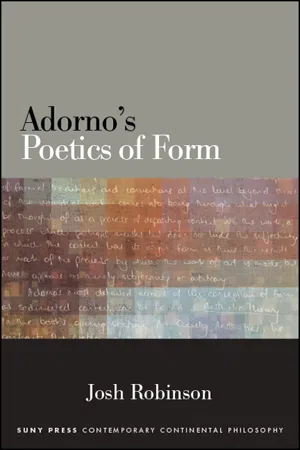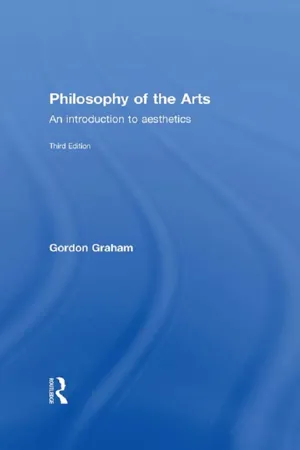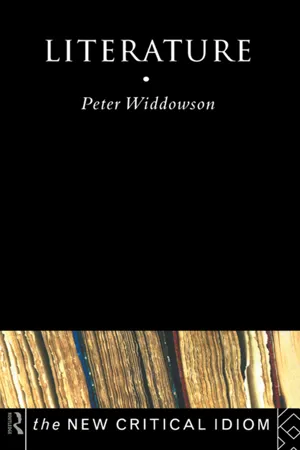Literary Form
Literary form refers to the structure and organization of a literary work, such as poetry, prose, drama, or other specific genres. It encompasses the way in which a piece of literature is written and presented, including elements like rhyme, meter, narrative structure, and style. Understanding the literary form of a work can provide insight into its meaning and impact.
7 Key excerpts on "Literary Form"
- eBook - ePub
- Laura Winkiel(Author)
- 2017(Publication Date)
- Routledge(Publisher)
...In effect, the massive historical, social and conceptual changes that occurred during the twentieth century were likewise felt in the transformation of Literary Form. An attentive reader will notice that our three chapters – “Concepts,” “Histories” and “Forms” – are really three facets of the same phenomenon of modernism. Each is necessary to the transformation of the other. Without sweeping historical changes, for instance, artistic form wouldn’t feel confined and artificial. We merely separate these aspects in order to make sense of one element at a time, but we should recognize that they mutually inform one another. In the epigram above, for example, German playwright and poet Bertolt Brecht states that the representation of reality is constantly changing and that artists cannot look to “existing works,” but should consider contemporary changes in philosophy, science, politics and everyday life in order to create artistic forms in which people can grasp what is occurring around them. Let’s see how this urge to alter Literary Form shaped modernist fiction, drama and poetry. Fiction Fiction is a form of literature that includes the novel and the short story. While we will discuss some modernist short stories below, we will mainly focus on the novel. Unlike other Literary Forms such as lyric poetry and drama, the novel is primarily concerned with “particular people in particular circumstances” (Watt 15). Its characters have proper names, as if they were real individuals, and are usually ordinary people. Their lives are depicted through realism, a mode of representation whose aim is to present “a full and authentic report of human experiences [… by means of] a more largely referential use of language than is common in other Literary Forms” (Watt 32). By “referential use of language,” Watt means a kind of lifelikeness, or verisimilitude, a close correspondence between word and thing and between language and reality...
- eBook - ePub
- Tonya Krouse, Tamara F. O'Callaghan(Authors)
- 2020(Publication Date)
- Bloomsbury Academic(Publisher)
...Further, they are complicated by the other methods that we use to categorize Literature. For example, when we categorize Literature according to its genre, we attend to the formal characteristics of the writing through which the ideas in the text are expressed. Genres of Literature Poetry • A written work that pays great attention to the sounds of language, in the forms of rhyme, meter, and other poetic devices like alliteration, metaphor, simile, and imagery. • Typical poetic forms include the sonnet, lyric poetry, the ode, or free verse. Drama • A script that is meant to be performed for an audience by actors, which includes stage directions and dialogue. Fiction • A prose narrative that tells an imagined story, with an emphasis on exposition, narrative point-of-view, plot, and characterization. • Typical fiction types. include the short story, the novel, and the graphic novel. Creative Nonfiction • A prose narrative that tells a true story, using many of the stylistic techniques of fiction. Cinema • A visual narrative, much like drama, that is meant to be performed and recorded. • An emergent form of cinema, beyond feature-length productions and television series, is video games. When we evaluate Literature by attending to genre, we might find similarities between texts that come from very different historical periods or very different national literary traditions...
- eBook - ePub
- Ralph Cohen, Ralph Cohen(Authors)
- 2022(Publication Date)
- Routledge(Publisher)
...4 The Life and Death of Literary Forms Alastair Fowler DOI: 10.4324/9781003247937-5 I. Forms and the Literary Model T HE SUBJECT proposed is the “life” and “death” of Literary Forms, not of literary works (a different subject). We say that the mock epic form has died out but The Rape of the Lock in some sense lives on, that the sonnet continues viable though Constable’s Sonnets are moribund, that pastoral persists in fresh guise, even if Googe’s Eclogues do not. The historical duration of works need not coincide with the duration of the forms they use. However, I must not take this as axiomatic, since for certain meanings of form it would be untrue. If forms meant personal configurations —as in Buffon’s le style est l’homme même—they might be coterminous with individual literary works. And a Crocean idealist who thought of form as “expression-intuition” would not even want to distinguish it from the internal event of the work; 1 for him, each work is formally unique, the diachronic propositions of literary history meaningless. Best begin, then, by specifying a literary model. 1 See René Wellek, Concepts of Criticism, ed. S. G. Nichols (New Haven and London, 1963), p. 56. The theoretical model currently useful is likely to be based on recent ideas of the substrate, and consequently to draw on post-Saussurean linguistics and on information theory. Thus we may define a literary work as the record of a specialized speech act. An author makes and communicates it, much as speakers express themselves, through a system of shared grammatical rules—Saussure’s langue—supplemented by other more specialized systems of conventions. 2 His individual speech act, however, is parole, a unique contingent communication, which, though it depends on previously shared conventions, may also modify them to initiate new conventions...
- eBook - ePub
- Josh Robinson(Author)
- 2018(Publication Date)
- SUNY Press(Publisher)
...In other words: the process by which these schemata might be thought to come into being is not presumed as a given, but rather a central element of this investigation. While I agree to a great extent with Alastair Fowler’s claim that consideration of developments within genre ‘offers frequent reminders that works of literature come to us from literary communities, with which we in our turn have to form a relation’, my aim is not ‘to break the hermeneutic circle and to reconstruct old or difficult works’. 2 Nor do I wish, in the first instance, to ‘recover a sense of the variety of Literary Forms’, or to advance either an account of the different literary genres or a universal theory of genre, but rather more specifically to understand how Adorno’s understanding of genre interacts with other aspects of his theory of form. 3 More particularly, my aim is to consider what the conception of form as genre has in common with other ways of understanding form, and to investigate the significance of the agglomeration of all these senses of form within a single concept. Indeed, the intellectual significance of an understanding of genre is not limited to the literary-historical attempt to reconstruct the social and political conditions under which particular works of art or literature originated, but is more fundamentally related to investigations into the nature of thinking. Rose has claimed that ‘[t]he exposition of poetry and prose as literary genres draws on the contrast of social and political cohesion already elaborated as social precondition’...
- eBook - ePub
Philosophy of the Arts
An Introduction to Aesthetics
- Gordon Graham(Author)
- 2005(Publication Date)
- Routledge(Publisher)
...We can be led in many different and competing directions by arguments and experiments which all claim validity, and so too we may expect poetic revelation to throw up a variety of images for our consideration. But enough has been said to establish the claim that poetic form is not just an agreeably ornamental way of saying things whose truth or substance is to be established in some other way. The relation between what is said in poetry and how it is said can be more intimate than that. However, even if it is accepted that poetry as a form of understanding does not yield to paraphrase without significant loss there is a further question for this chapter to address: can the same be said of the other literary arts? The poetic forms described and discussed so far are closely connected with ‘poetry’ narrowly understood. Other literary arts have other forms, and it needs to be shown that these are also ways of directing the mind to a better apprehension of some aspect of human experience. Can storytelling, whose form is narrative, be used in this way? Narrative and fiction The device of multilayered representation is to be found in novels as well as in poetry. A striking counterpart in this respect to Browning's My Last Duchess is Kazuo Ishiguro's novel The Remains of the Day, subsequently made into a highly successful film. Ishiguro's story is set in the England of the 1950s. The principal character is a butler, Stevens, who takes a few days' holiday motoring across the countryside with the ultimate purpose of seeking out a former colleague. The journey provides the occasion and the context for extended reminiscences of previous, rather more glorious periods of service. The story is told in the first person from the butler's point of view and, to a degree, Stevens reminisces in order to construct an apologia, a self-justification of his past actions and attitudes...
- eBook - ePub
- Peter Widdowson(Author)
- 2013(Publication Date)
- Routledge(Publisher)
...Of course, publishing, reviewing and academic criticism – if not, by definition, ‘literary competence’ itself – mean that no literary text can ever be entirely unmediated (for example, by being described as ‘a classic’, ‘Caribbean poetry’, ‘a romance’, ‘Restoration Comedy’, etc.). But I am working on the hypothesis that a reader coming to such a text for the first time will read it ‘for themselves’ as the primary act of comprehension. As a result of this common accessibility and unmediatedness, therefore, ‘the literary’ is amongst the most democratic of art forms: as witnessed both in its pervasive popularity, and in its fear-induced censorship by those who most wish to curtail freedoms. It is for these reasons that its uses, both as a practice of writing and as an object of reading, have been and remain so legion, multifarious, and valued. But if this substantive functionalist claim for the importance of ‘the literary’ – and for its retention as a crucial ‘space’ in contemporary and future culture – is to be justified and sustained, my definition of it will need to be grounded in the identification of some of those uses. It is to a more extended and illustrated analysis of ‘the uses of the literary’, therefore, that the next chapter now turns....
- Josephine Guy, Ian Small(Authors)
- 2010(Publication Date)
- Routledge(Publisher)
...Such mechanisms might involve examining the range, status and consistency of evidence available to the historian, as well as considering the role played by narrative devices in organising this evidence into an explanation of past events. Importantly for the subject of this chapter, these weaker arguments also have ramifications for how we understand the relationship between literature and its historical context. They remind us of the truism that history is constantly being rewritten; so too, therefore, are those events (or contexts) with which literary works allegedly engage. As a consequence, we cannot assume that there are fixed historical events, or unproblematic historical ‘facts’ about social life, on the one hand, and a literary representation of them, on the other. More to the point, we need to be aware that literary works themselves may be part of that process by which we rewrite the past. To put this another way: a literary work and its context do not exist as conceptually separate entities, as is suggested by the commonly used language of optics – the language, that is, of ‘reflection’ and ‘representation’ which presupposes two ontologically separate entities: an object and an image of it. Instead, we might better think about literature and context as existing in a dynamic relationship with each other. Context may be constitutive of literature, in the sense of placing constraints on expressivity; conversely, literature may also be constitutive of context, insofar as literary works themselves, and the formal devices associated with literary expression, may be deeply implicated in the way readers understand the social world around them, and thus also in the ways in which knowledge of the past is constructed. For all of these reasons defining precisely the way in which literary works and contexts relate to each other can be a surprisingly complicated task. This chapter will attempt to give a sense of that complexity...
